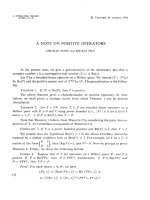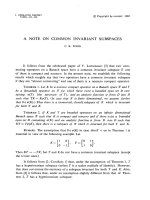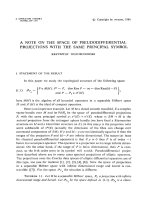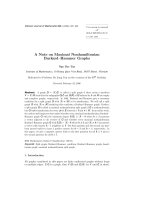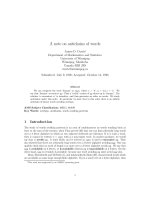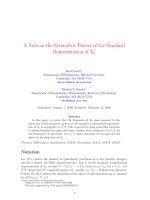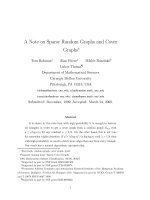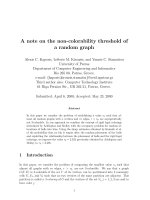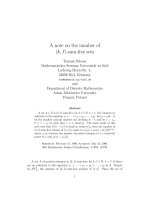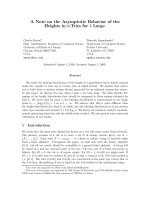Báo cáo toán học: "A note on three types of quasisymmetric functions" docx
Bạn đang xem bản rút gọn của tài liệu. Xem và tải ngay bản đầy đủ của tài liệu tại đây (110.69 KB, 10 trang )
A note on three types of quasisymmetric functions
T. Kyle Petersen
Department of Mathematics
Brandeis University, Waltham, MA, USA
Submitted: Aug 8, 2005; Accepted: Nov 14, 2005; Published: Nov 22, 2005
Mathematics Subject Classifications: 05E99, 16S34
Abstract
In the context of generating functions for P -partitions, we revisit three flavors
of quasisymmetric functions: Gessel’s quasisymmetric functions, Chow’s type B
quasisymmetric functions, and Poirier’s signed quasisymmetric functions. In each
case we use the inner coproduct to give a combinatorial description (counting pairs of
permutations) to the multiplication in: Solomon’s type A descent algebra, Solomon’s
type B descent algebra, and the Mantaci-Reutenauer algebra, respectively. The
presentation is brief and elementary, our main results coming as consequences of
P -partition theorems already in the literature.
1 Quasisymmetric functions and Solomon’s descent
algebra
The ring of quasisymmetric functions is well-known (see [12], ch. 7.19). Recall that a
quasisymmetric function is a formal series
Q(x
1
,x
2
, ) ∈ Z[[x
1
,x
2
, ]]
of bounded degree such that the coefficient of x
α
1
i
1
x
α
2
i
2
···x
α
k
i
k
is the same for all i
1
<
i
2
< ··· <i
k
and all compositions α =(α
1
,α
2
, ,α
k
). Recall that a composition of
n, written α |= n, is an ordered tuple of positive integers α =(α
1
,α
2
, ,α
k
) such that
|α| = α
1
+ α
2
+ ···+ α
k
= n. In this case we say that α has k parts, or #α = k.Wecan
put a partial order on the set of all compositions of n by reverse refinement. The covering
relations are of the form
(α
1
, ,α
i
+ α
i+1
, ,α
k
) ≺ (α
1
, ,α
i
,α
i+1
, ,α
k
).
Let Qsym
n
denote the set of all quasisymmetric functions homogeneous of degree n.The
ring of quasisymmetric functions can be defined as Qsym :=
n≥0
Qsym
n
, but our focus
will stay on the quasisymmetric functions of degree n, rather than the ring as a whole.
the electronic journal of combinatorics 12 (2005), #R61 1
The most obvious basis for Qsym
n
is the set of monomial quasisymmetric functions,
defined for any composition α =(α
1
,α
2
, ,α
k
) |= n,
M
α
:=
i
1
<i
2
<···<i
k
x
α
1
i
1
x
α
2
i
2
···x
α
k
i
k
.
We can form another natural basis with the fundamental quasisymmetric functions, also
indexed by compositions,
F
α
:=
α β
M
β
,
since, by inclusion-exclusion we can express the M
α
in terms of the F
α
:
M
α
=
α β
(−1)
#β−#α
F
β
.
As an example,
F
(2,1)
= M
(2,1)
+ M
(1,1,1)
=
i<j
x
2
i
x
j
+
i<j<k
x
i
x
j
x
k
=
i≤j<k
x
i
x
j
x
k
.
Compositions can be used to encode descent classes of permutations in the following
way. Recall that a descent of a permutation π ∈ S
n
is a position i such that π
i
>π
i+1
,
and that an increasing run of a permutation π is a maximal subword of consecutive
letters π
i+1
π
i+2
···π
i+r
such that π
i+1
<π
i+2
< ··· <π
i+r
. By maximality, we have
that if π
i+1
π
i+2
···π
i+r
is an increasing run, then i is a descent of π (if i =0),and
i + r is a descent of π (if i + r = n). For any permutation π ∈ S
n
define the descent
composition, C(π), to be the ordered tuple listing the lengths of the increasing runs of π.
If C(π)=(α
1
,α
2
, ,α
k
), we can recover the descent set of π:
Des(π)={α
1
,α
1
+ α
2
, ,α
1
+ α
2
+ ···+ α
k−1
}.
Since C(π)andDes(π) have the same information, we will use them interchangeably. For
example the permutation π =(3, 4, 5, 2, 6, 1) has C(π)=(3, 2, 1) and Des(π)={3, 5}.
Recall ([11], ch. 4.5) that a P-partition is an order-preserving map from a poset P
to some (countable) totally ordered set. To be precise, let P be any labeled partially
ordered set (with partial order <
P
)andletS be any totally ordered countable set. Then
f : P → S is a P -partition if it satisfies the following conditions:
1. f(i) ≤ f(j)ifi<
P
j
2. f(i) <f(j)ifi<
P
j and i>j(as labels)
We let A(P )(orA(P ; S) if we want to emphasize the image set) denote the set of all
P -partitions, and encode this set in the generating function
Γ(P ):=
f∈A(P )
x
f(1)
x
f(2)
···x
f(n)
,
the electronic journal of combinatorics 12 (2005), #R61 2
where n is the number of elements in P (we will only consider finite posets). If we take S
to be the set of positive integers, then it should be clear that Γ(P ) is always going to be
a quasisymmetric function of degree n.Asaneasyexample,letP be the poset defined
by 3 >
P
2 <
P
1. In this case we have
Γ(P )=
f(3)≥f (2)<f(1)
x
f(1)
x
f(2)
x
f(3)
.
We can consider permutations to be labeled posets with total order π
1
<
π
π
2
<
π
···<
π
π
n
. With this convention, we have
A(π)={f :[n] → S |f(π
1
) ≤ f (π
2
) ≤···≤f(π
n
)
and k ∈ Des(π) ⇒ f(π
k
) <f(π
k+1
)},
and
Γ(π)=
i
1
≤i
2
≤···≤i
n
k∈Des(π)⇒i
k
<i
k+1
x
i
1
x
i
2
···x
i
n
.
It is not hard to verify that in fact we have
Γ(π)=F
C(π)
,
so that generating functions for the P -partitions of permutations of π ∈ S
n
form a basis
for Qsym
n
.
We have the following theorem related to P -partitions of permutations, due to Gessel
[5].
Theorem 1 As sets, we have the bijection
A(π; ST) ↔
στ=π
A(τ; S) ⊕A(σ; T),
where ST is the cartesian product of the sets S and T with the lexicographic ordering.
Let X = {x
1
,x
2
, } and Y = {y
1
,y
2
, } be two two sets of commuting indetermi-
nates. Then we define the bipartite generating function,
Γ(π)(XY )=
(i
1
,j
1
)≤(i
2
,j
2
)≤···≤(i
n
,j
n
)
k∈Des(π)⇒(i
k
,j
k
)<(i
k+1
,j
k+1
)
x
i
1
···x
i
n
y
j
1
···y
j
n
.
We will apply Theorem 1 with S = T = P, the positive integers.
Corollary 1 We have
F
C(π)
(XY )=
στ=π
F
C(τ )
(X)F
C(σ)
(Y ).
the electronic journal of combinatorics 12 (2005), #R61 3
Following [5], we can define a coalgebra structure on Qsym
n
in the following way. If
π is any permutation with C(π)=γ,leta
γ
α,β
denote the number of pairs of permutations
(σ, τ ) ∈ S
n
× S
n
with C(σ)=α, C(τ)=β,andστ = π. Then Corollary 1 defines a
coproduct Qsym
n
→Qsym
n
⊗Qsym
n
:
F
γ
→
α,β|=n
a
γ
α,β
F
β
⊗ F
α
.
If Qsym
∗
n
, with basis {F
∗
α
}, is the algebra dual to Qsym
n
, then by definition it is equipped
with multiplication
F
∗
β
∗ F
∗
α
=
γ
a
γ
α,β
F
∗
γ
.
Let ZS
n
denote the group algebra of the symmetric group. We can define its dual
coalgebra ZS
∗
n
with comultiplication
π →
στ=π
τ ⊗ σ.
Then by Corollary 1 we have a surjective homomorphism of coalgebras ϕ
∗
: ZS
∗
n
→
Qsym
n
given by
ϕ
∗
(π)=F
C(π)
.
The dualization of this map is then an injective homomorphism of algebras ϕ : Qsym
∗
n
→
ZS
n
with
ϕ(F
∗
α
)=
C(π)=α
π.
The is image of ϕ is then a subalgebra of the group algebra, with basis
u
α
:=
C(π)=α
π.
This subalgebra is well-known as Solomon’s descent algebra [10], denoted Sol(A
n−1
).
Corollary 1 has then given a combinatorial description to multiplication in Sol(A
n−1
):
u
β
u
α
=
γ|=n
a
γ
α,β
u
γ
.
The above arguments are due to Gessel [5]. We give them here in full detail for compar-
ison with later sections, when we will outline a similar relationship between Chow’s type
B quasisymmetric functions [4] and Sol(B
n
), and between Poirier’s signed quasisymmetric
functions [9] and the Mantaci-Reutenauer algebra.
the electronic journal of combinatorics 12 (2005), #R61 4
2 Type B quasisymmetric functions and Solomon’s
descent algebra
The type B quasisymmetric functions can be viewed as the natural objects related to
type B P -partitions (see [4]). Define the type B posets (with 2n + 1 elements) to be
posets labeled distinctly by {−n, ,−1, 0, 1, ,n} with the property that if i<
P
j,
then −j<
P
−i. For example, −2 >
P
1 <
P
0 <
P
−1 >
P
2isatypeBposet.
Let P be any type B poset, and let S = {s
0
,s
1
, } be any countable totally ordered
set with a minimal element s
0
.ThenatypeBP -partition is any map f : P →±S such
that
1. f(i) ≤ f(j)ifi<
P
j
2. f(i) <f(j)ifi<
P
j and i>j(as labels)
3. f(−i)=−f(i)
where ±S is the totally ordered set
···< −s
2
< −s
1
<s
0
<s
1
<s
2
< ···
If S is the nonnegative integers, then ±S is the set of all integers.
The third property of type B P -partitions means that f(0) = 0 and the set {f (i) |
i =1, 2, ,n} determines the map f.WeletA
B
(P )=A
B
(P ; ±S)denotethesetofall
type B P -partitions, and define the generating function for type B P -partitions as
Γ
B
(P ):=
f∈A
B
(P )
x
|f(1)|
x
|f(2)|
···x
|f(n)|
.
Signed permutations π ∈ B
n
are type B posets with total order
−π
n
< ···< −π
1
< 0 <π
1
< ···<π
n
.
We then have
A
B
(π)={f : ±[n] →±S | 0 ≤ f (π
1
) ≤ f (π
2
) ≤···≤f(π
n
),
f(−i)=−f(i),
and k ∈ Des
B
(π) ⇒ f (π
k
) <f(π
k+1
)},
and
Γ
B
(π)=
0≤i
1
≤i
2
≤···≤i
n
k∈Des(π)⇒i
k
<i
k+1
x
i
1
x
i
2
···x
i
n
.
Here, the type B descent set, Des
B
(π), keeps track of the ordinary descents as well as a
descent in position 0 if π
1
< 0. Notice that if π
1
< 0, then f (π
1
) > 0, and Γ
B
(π)hasno
x
0
terms, as in
Γ
B
((−3, 2, −1)) =
0<i≤j<k
x
i
x
j
x
k
.
the electronic journal of combinatorics 12 (2005), #R61 5
The possible presence of a descent in position zero is the crucial difference between
type A and type B descent sets. Define a pseudo-composition of n to be an ordered tuple
α =(α
1
, ,α
k
)withα
1
≥ 0, and α
i
> 0 for i>1, such that α
1
+ ···+ α
k
= n. We write
α n to mean α is a pseudo-composition of n. Define the descent pseudo-composition
C
B
(π) of a signed permutation π be the lengths of its increasing runs as before, but now
we have α
1
=0ifπ
1
< 0. As with ordinary compositions, the partial order on pseudo-
compositions of n is given by reverse refinement. We can move back and forth between
descent pseudo-compositions and descent sets in exactly the same way as for type A. If
C
B
(π)=(α
1
, ,α
k
), then we have
Des
B
(π)={α
1
,α
1
+ α
2
, ,α
1
+ α
2
+ ···+ α
k−1
}.
We will use pseudo-compositions of n to index the type B quasisymmetric functions.
Define BQsym
n
as the vector space of functions spanned by the type B monomial qua-
sisymmetric functions:
M
B,α
:=
0<i
2
<···<i
k
x
α
1
0
x
α
2
i
2
···x
α
k
i
k
,
where α =(α
1
, ,α
k
) is any pseudo-composition, or equivalently by the type B funda-
mental quasisymmetric functions:
F
B,α
:=
α β
M
B,β
.
The space of all type B quasisymmetric functions is defined as the direct sum BQsym :=
n≥0
BQsym
n
. By design, we have
Γ
B
(π)=F
B,C
B
(π)
.
From Chow [4] we have the following theorem and corollary.
Theorem 2 As sets, we have the bijection
A
B
(π; ST) ↔
στ=π
A
B
(τ; S) ⊕A
B
(σ; T),
where ST is the cartesian product of the sets S and T with the lexicographic ordering.
We take S = T = Z andwehavethefollowing.
Corollary 2 We have
F
B,C
B
(π)
(XY )=
στ=π
F
B,C
B
(τ)
(X)F
B,C
B
(σ)
(Y ).
the electronic journal of combinatorics 12 (2005), #R61 6
The coalgebra structure on BQsym
n
works just the same as in the type A case.
Corollary 2 gives us the coproduct
F
B,γ
→
α,β n
b
γ
α,β
F
B,β
⊗ F
B,α
,
where for any π such that C
B
(π)=γ, b
γ
α,β
is the number of pairs of signed permutations
(σ, τ ) such that C
B
(σ)=α, C
B
(τ)=β,andστ = π. The dual algebra is isomorphic to
Sol(B
n
), where if u
α
is the sum of all signed permutations with descent pseudo-composition
α, the multiplication given by
u
β
u
α
=
γ n
b
γ
α,β
u
γ
.
3 Signed quasisymmetric functions and the Mantaci-
Reutenauer algebra
One thing to have noticed about the generating function for type B P -partitions is that we
are losing a certain amount of information when we take absolute values on the subscripts.
We can think of signed quasisymmetric functions as arising naturally by dropping this
restriction.
For a type B poset P , define the signed generating function for type B P -partitions
to be
Γ(P ):=
f∈A
B
(P )
x
f(1)
x
f(2)
···x
f(n)
,
where we will write
x
i
=
u
i
if i<0,
v
i
if i ≥ 0.
InthecasewhereP is a signed permutation, we have
Γ(π)=
0≤i
1
≤i
2
≤···≤i
n
s∈Des
B
(π)⇒i
s
<i
s+1
π
s
<0⇒x
i
s
=u
i
s
π
s
>0⇒x
i
s
=v
i
s
x
i
1
x
i
2
···x
i
n
,
so that now we are keeping track of the set of minus signs of our signed permutation along
with the descents. For example,
Γ((−3, 2, −1)) =
0<i≤j<k
u
i
v
j
u
k
.
To keep track of both the set of signs and the set of descents, we introduce the
signed compositions as used in [3]. A signed composition α of n, denoted α n,is
a tuple of nonzero integers (α
1
, ,α
k
) such that |α
1
| + ···+ |α
k
| = n. For any signed
the electronic journal of combinatorics 12 (2005), #R61 7
permutation π we will associate a signed composition sC(π) by simply recording the length
of increasing runs with constant sign, and then recording that sign. For example, if π =
(−3, 4, 5, −6, −2, −7, 1), then sC(π)=(−1, 2, −2, −1, 1). The signed composition keeps
track of both the set of signs and the set of descents of the permutation as we demonstrate
with an example. If sC(π)=(−3, 2, 1, −2, 1), then we know that π is a permutation in S
9
such that π
4
,π
5
,π
6
,andπ
9
are positive, whereas the rest are all negative. The descents
of π are in positions 5 and 6. Note that for any ordinary composition of n with k parts,
there are 2
k
signed compositions, leading us to conclude that there are
n
k=1
n − 1
k − 1
2
k
=2· 3
n−1
signed compositions of n. The partial order on signed compositions is given by reverse
refinement with constant sign, i.e., the cover relations are still of the form:
(α
1
, ,α
i
+ α
i+1
, ,α
k
) ≺ (α
1
, ,α
i
,α
i+1
, ,α
k
),
but now α
i
and α
i+1
have to have the same sign. For example, if n =2,wehavethe
following partial order:
(2) ≺ (1, 1)
(−1, 1)
(1, −1)
(−2) ≺ (−1, −1)
We will use signed compositions to index the signed quasisymmetric functions (see
[9]). For any signed composition α, define the monomial signed quasisymmetric function
M
α
:=
i
1
<i
2
<···<i
k
α
r
<0⇒x
i
r
=u
i
r
α
r
>0⇒x
i
r
=v
i
r
x
|α
1
|
i
1
x
|α
2
|
i
2
···x
|α
k
|
i
k
,
and the fundamental signed quasisymmetric function
F
α
:=
α β
M
β
.
By construction, we have
Γ(π)=F
sC(π)
.
Notice that if we set u = v, then our signed quasisymmetric functions become type B
quasisymmetric functions.
Let SQsym
n
denote the span of the M
α
(or F
α
), taken over all α n.Thespaceof
all signed quasisymmetric functions, SQsym :=
n≥0
SQsym
n
, is a graded ring whose
n-th graded component has rank 2 · 3
n−1
. We will relate this to the Mantaci-Reutenauer
algebra.
the electronic journal of combinatorics 12 (2005), #R61 8
Theorem 2 is a statement about splitting apart bipartite P -partitions, independent
of how we choose to encode the information. So while Corollary 2 is one such way of
encoding the information of Theorem 2, the following is another.
Corollary 3 We have
F
sC(π)
(XY )=
στ=π
F
sC(τ )
(X)F
sC(σ)
(Y ).
We define a coalgebra structure on SQsym
n
as we did in the earlier cases. Let π ∈ B
n
be any signed permutation with sC(π)=γ,andletc
γ
α,β
be the number of pairs of
permutations (σ, τ ) ∈ B
n
× B
n
with sC(σ)=α, sC(τ )=β,andστ = π. Corollary 3
gives a coproduct SQsym
n
→SQsym
n
⊗SQsym
n
:
F
γ
→
α,β n
c
γ
α,β
F
β
⊗ F
α
.
Multiplication in the dual algebra SQsym
∗
n
is given by
F
∗
β
∗ F
∗
α
=
γ n
c
γ
α,β
F
∗
γ
.
The group algebra of the hyperoctahedral group, ZB
n
, has a dual coalgebra ZB
∗
n
with
comultiplication given by the map
π →
στ=π
τ ⊗ σ.
By Corollary 3, the following is a surjective homomorphism of coalgebras ψ
∗
: ZB
∗
n
→
SQsym
n
given by
ψ
∗
(π)=F
sC(π)
.
The dualization of this map is an injective homomorphism ψ : SQsym
∗
n
→ ZB
n
with
ψ(
F
∗
α
)=
sC(π)=α
π.
The image of ψ is then a subalgebra of ZB
n
of dimension 2 · 3
n−1
, with basis
v
α
:=
sC(π)=α
π.
This subalgebra is called the Mantaci-Reutenauer algebra [6], with multiplication given
explicitly by
v
β
v
α
=
γ n
c
γ
α,β
v
γ
.
The duality between SQsym
n
and the Mantaci-Reutenauer algebra was shown in
[1], and the bases {
F
α
} and {v
α
} are shown to be dual in [2], but the the P -partition
the electronic journal of combinatorics 12 (2005), #R61 9
approach to the problem is new. As the Mantaci-Reutenauer algebra is defined for any
wreath product C
m
S
n
, i.e., any “m-colored” permutation group, it would be nice to
develop a theory of colored P -partitions to tell the dual story in general.
In closing, we remark that this same method was put to use in [8], where Stembridge’s
enriched P -partitions [13] were generalized and put to use to study peak algebras. Vari-
ations on the theme can also be found in [7].
References
[1] P. Baumann and C. Hohlweg, A Solomon descent theory for the wreath products
G S
n
, arXiv: math.CO/0503011.
[2] N. Bergeron and C. Hohlweg, Coloured peak algebras and hopf algebras, arXiv:
math.AC/0505612.
[3] C. Bonnaf´e and C. Hohlweg, Generalized descent algebra and construction of irre-
ducible characters of hyperoctahedral groups, arXiv: math.CO/0409199 .
[4] C O. Chow, Noncommutative symmetric functions of type B, Ph.D. thesis, MIT
(2001).
[5] I. Gessel, Multipartite P -partitions and inner products of skew Schur functions,Con-
temporary Mathematics 34 (1984), 289–317.
[6] R. Mantaci and C. Reutenauer, A generalization of Solomon’s algebra for hyperoc-
tahedral groups and other wreath products, Communications in Algebra 23 (1995),
27–56.
[7] T.K. Petersen, Cyclic descents and P -partitions, to appear in Journal of Algebraic
Combinatorics.
[8] T.K. Petersen, Enriched P -partitions and peak algebras, arXiv: math.CO/0508041.
[9] S. Poirier, Cycle type and descent set in wreath products, Discrete Mathematics 180
(1998), 315–343.
[10] L. Solomon, A Mackey formula in the group ring of a finite Coxeter group, Journal
of Algebra 41 (1976), 255–264.
[11] R. Stanley, Enumerative Combinatorics, Volume I, Wadsworth & Brooks/Cole, 1986.
[12] R. Stanley, Enumerative Combinatorics, Volume II, Cambridge University Press,
2001.
[13] J. Stembridge, Enriched P -partitions, Transactions of the American Mathematical
Society 349 (1997), 763–788.
the electronic journal of combinatorics 12 (2005), #R61 10
